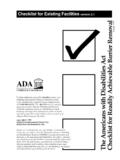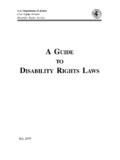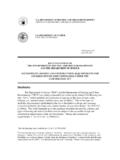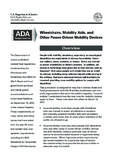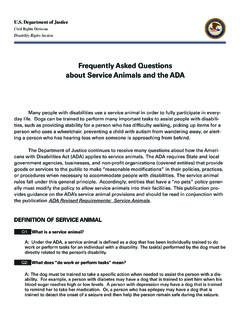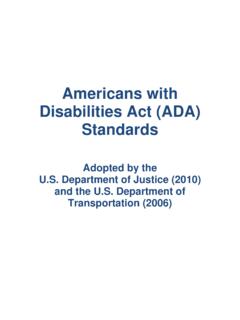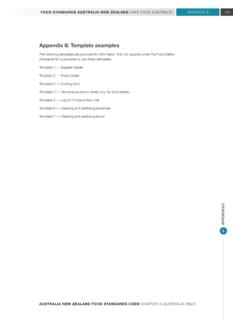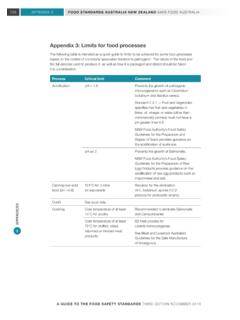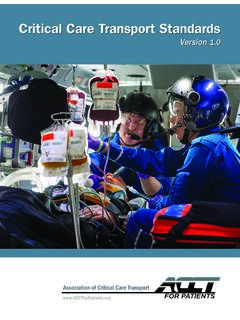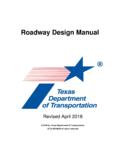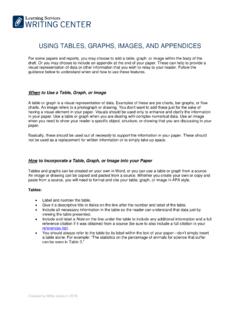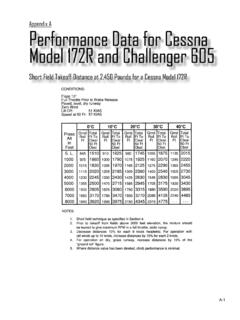Transcription of 2010 ADA Standards for Accessible Design
1 Department of JusticeSeptember 15, 20102010 ADA Standardsfor Accessible DesignReproduction of this document is publication may be viewed or downloadedfrom the ADA website ( ). Additional copies may be obtained by calling the ADA Information Line:800-514-0301 (voice)800-514-0383 (TTY)September 15, 2010iDepartment of Standards for State andLocal Government Facilities: Title Standards for Public Accommodations and Commercial Facilities: Title Standards for Titles IIand III Facilities: 2004 of JusticeiiContentsiiiDepartment of JusticeThe Department of Justice published revised regulations for Titles II and III of the Americans with Disabilities Act of 1990 "ADA" in the Federal Register on September 15, 2010. These regulations adopted revised, enforceable accessibility Standards called the 2010 ADA Standards for Accessible Design "2010 Standards " or " Standards ".
2 The 2010 Standards set minimum requirements both scoping and technical for newly designed and constructed or altered State and local government facilities, public accommodations, and commercial facilities to be readily Accessible to and usable by individuals with of the 2010 Standards also establishes a revised reference point for Title II entities that choose to make structural changes to existing facilities to meet their program accessibility requirements; and it establishes a similar reference for Title III entities undertaking readily achievable barrier Department is providing this document with the official 2010 Standards in one publication. The document includes: The 2010 Standards for State and local governments, which consist of the Title II regulations at 28 CFR and the 2004 ADAAG at 36 CFR part 1191, appendices B and D; The 2010 Standards for public accommodations and commercial facilities, which consist of the Title III regulations at 28 CFR part 36, subpart D, and the 2004 ADAAG at 36 CFR part 1191, appendices B and D.
3 The Department has assembled into a separate publication the revised regulation guidance that applies to the Standards . The Department included guidance in its revised ADA regulations published on September 15, 2010. This guidance provides detailed information about the Department s adoption of the 2010 Standards including changes to the Standards , the reasoning behind those changes, and responses to public comments received on these topics. The document, Guidance on the 2010 ADA Standards for Accessible Design , can be downloaded from More InformationFor information about the ADA, including the revised 2010 ADA regulations, please visit the Department s website ; or, for answers to specific questions, call the toll-free ADA Information Line at 800-514-0301 (Voice) or 800-514-0383 (TTY).Department of Justice1 Overview2 Department of JusticeState and local government facilities must follow the requirements of the 2010 Standards , including both the Title II regulations at 28 CFR ; and the 2004 ADAAG at 36 CFR part 1191, appendices B and the few places where requirements between the two differ, the requirements of 28 CFR prevail.
4 Compliance Date for Title IIIf the start date for construction is on or after March 15, 2012, all newly constructed or altered State and local government facili-ties must comply with the 2010 Standards . Before that date, the 1991 Standards (without the elevator exemption), the UFAS, or the 2010 Standards may be used for projects when the start of construction commences on or after September 15, Standards for Stateand Local GovernmentFacilities: Title II2010 Standards : Title II - 3 Department of Justice4 - 2010 Standards : Title IIDepartment of Justice2010 Standards : Title II - 5 Section of 28 CFR Part 35 CONTENTS28 CFR part New Construction and Alterations (a) Design and construction, including the exception for structural (b) Alterations, including alterations to historic properties, path of travel, and primary function.
5 6(c) Accessibility Standards and compliance date ..9(d) Scope of (e) Social service center (f) Housing at a place of (g) Assembly (h) Medical care facilities ..13(i) Curb (j) Facilities with residential dwelling units for sale to individual (k) Detention and correctional ADAAGC hapter 1: Application and 37 Chapter 2: Scoping 3: Building Chapter 4: Accessible 5: General Site and Building 6: Plumbing Elements and 7: Communication 8: Special Rooms, Spaces, and 9: Built-in 10: Recreational of Justice6 - 2010 Standards : Title IISection of 28 CFR Part 35 New construction and alterations.(a) Design and construction. (1) Each facility or part of a facility constructed by, on behalf of, or for the use of a public entity shall be designed and constructed in such manner that the facility or part of the facility is readily Accessible to and usable by individuals with disabilities, if the construction was commenced after January 26, 1992.
6 (2) Exception for structural impracticability. (i) Full compliance with the requirements of this section is not required where a public entity can demonstrate that it is structurally impracticable to meet the requirements. Full compliance will be considered structurally impracticable only in those rare circumstances when the unique characteristics of terrain prevent the incorporation of accessibility features.(ii) If full compliance with this section would be structurally impracticable, compliance with this section is required to the extent that it is not structurally impracticable. In that case, any portion of the facility that can be made Accessible shall be made Accessible to the extent that it is not structurally impracticable.(iii) If providing accessibility in conformance with this section to individuals with certain disabilities ( , those who use wheelchairs) would be structurally impracticable, accessibility shall nonetheless be ensured to persons with other types of disabilities, ( , those who use crutches or who have sight, hearing, or mental impairments) in accordance with this section.
7 (b) Alterations. (1) Each facility or part of a facility altered by, on behalf of, or for the use of a public entity in a manner that affects or could affect the usability of the facility or part of the facility shall, to the maximum extent feasible, be altered in such manner that the altered portion of the facility is readily Accessible to and usable by individuals with disabilities, if the alteration was commenced after January 26, 1992.(2) The path of travel requirements of (b)(4) shall apply only to alterations undertaken solely for purposes other than to meet the program accessibility requirements of of Justice2010 Standards : Title II - 7 Section of 28 CFR Part 35(3) (i) Alterations to historic properties shall comply, to the maximum extent feasible,with the provisions applicable to historic properties in the Design Standards specified in (c).
8 (ii) If it is not feasible to provide physical access to an historic property in a mannerthat will not threaten or destroy the historic significance of the building or facility, alternative methods of access shall be provided pursuant to the requirementsof (4) Path of travel. An alteration that affects or could affect the usability of or access to an area of a facility that contains a primary function shall be made so as to ensure that, to the maximum extent feasible, the path of travel to the altered area and the restrooms, telephones, and drinking fountains serving the altered area are readily Accessible to and usable by individuals with disabilities, including individuals who use wheelchairs, unless the cost and scope of such alterations is disproportionate to the cost of the overall alteration.(i) Primary function. A primary function is a major activity for which the facility is intended.
9 Areas that contain a primary function include, but are not limited to, the dining area of a cafeteria, the meeting rooms in a conference center, as well as offices and other work areas in which the activities of the public entity using the facility are carried out.(A) Mechanical rooms, boiler rooms, supply storage rooms, employee lounges or locker rooms, janitorial closets, entrances, and corridors are not areas containing a primary function. Restrooms are not areas containing a primary function unless the provision of restrooms is a primary purpose of the area, , in highway rest stops.(B) For the purposes of this section, alterations to windows, hardware, controls, electrical outlets, and signage shall not be deemed to be alterations that affect the usability of or access to an area containing a primary function.(ii) A path of travel includes a continuous, unobstructed way of pedestrian passage by means of which the altered area may be approached, entered, and exited, and which connects the altered area with an exterior approach (including sidewalks, streets, and parking areas), an entrance to the facility, and other parts of the facility.
10 (A) An Accessible path of travel may consist of walks and sidewalks, curb ramps Department of Justice8 - 2010 Standards : Title IISection of 28 CFR Part 35and other interior or exterior pedestrian ramps; clear floor paths through lobbies, corridors, rooms, and other improved areas; parking access aisles; elevators and lifts; or a combination of these elements.(B) For the purposes of this section, the term path of travel also includes the restrooms, telephones, and drinking fountains serving the altered area.(C) Safe harbor. If a public entity has constructed or altered required elements of a path of travel in accordance with the specifications in either the 1991 Standards or the Uniform Federal Accessibility Standards before March 15, 2012, the public entity is not required to retrofit such elements to reflect incremental changes in the 2010 Standards solely because of an alteration to a primary function area served by that path of travel.
